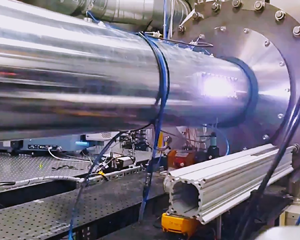Crossref Citations
This article has been cited by the following publications. This list is generated based on data provided by
Crossref.
Du, Yaowen
Sun, Surong
Tan, Meijing
Huang, Heji
Yan, Cong
Meng, Xian
Chen, Xuan
and
Wang, Haixing
2023.
Numerical study on the non-equilibrium characteristics of high-speed atmospheric re-entry flow and radiation of aircraft based on fully coupled model.
Journal of Fluid Mechanics,
Vol. 977,
Issue. ,
Tibère-Inglesse, Augustin C.
Cruden, Brett A.
Jelloian, Christopher
and
Spearrin, Raymond M.
2023.
Examination of Mars2020 shock-layer conditions via infrared emission spectroscopy of CO2.
Clarke, Justin
Di Mare, Luca
and
McGilvray, Matthew
2023.
Spatial Transformations for Reacting Gas Shock Tube Experiments.
AIAA Journal,
Vol. 61,
Issue. 8,
p.
3365.
Chang, Eric Won Keun
Joglekar, Chinmay
McGilvray, Matthew
and
Hermann, Tobias
2023.
Integration of Arc-jet in Impulse Facility for Hypervelocity Aerothermal Testing with Ablation.
Tibère-Inglesse, Augustin C.
Johnston, Christopher O.
Brandis, Aaron M.
and
Cruden, Brett A.
2023.
Dragonfly backshell radiation measurements in the EAST facility.
Collen, Peter L.
Glenn, Alex B.
Doherty, Luke J.
and
McGilvray, Matthew
2023.
Absolute Measurements of Air Shock-Layer Radiation in the T6 Aluminium Shock Tube.
Journal of Thermophysics and Heat Transfer,
Vol. 37,
Issue. 3,
p.
618.
Clarke, Justin
Collen, Peter L.
McGilvray, Matthew
and
di Mare, Luca
2023.
Numerical Simulation of a Shock Tube in Thermochemical Non-Equilibrium.
Collen, Peter L.
Di Mare, Luca
McGilvray, Matthew
and
Satchell, Matthew
2023.
Analysis of Shock Deceleration Effects in the NASA Electric Arc Shock Tube.
Journal of Thermophysics and Heat Transfer,
Vol. 37,
Issue. 2,
p.
503.
Kennedy, Aaron
Penty Geraets, Rowland T.
James, Christopher M.
Thompson, Matthew
Morgan, Richard G.
Austin, Joanna M.
Zander, Fabian
and
McGilvray, Matthew
2023.
Measurements of Hypersonic Double Cone Flows with Shock Wave/Boundary Layer Interactions in the X3 Expansion Tunnel.
Tang, Weixin
Ding, Tao
Li, Dongxian
and
Zhang, Changhua
2024.
Experimental investigation of non-equilibrium spectra for nitrogen behind strong shock waves.
Acta Astronautica,
Vol. 215,
Issue. ,
p.
44.
Steer, Joseph
Collen, Peter
Glenn, Alex
Hambidge, Christopher
Doherty, Luke J
McGilvray, Matthew
Sopek, Tamara
Loehle, Stefan
and
Walpot, Louis
2024.
Commissioning of Upgrades to T6 to Study Giant Planet Entry.
Journal of Spacecraft and Rockets,
p.
1.
Crumpton, Tristan J.
2024.
Analysis of Mars Entry Shock Wave Radiance in the T6 Stalker Hypersonic Wind Tunnel.
Sopek, Tamara
Glenn, Alex
Clarke, Justin
di Mare, Luca
Collen, Peter
and
McGilvray, Matthew
2024.
Radiative Heat Transfer Measurements of Titan Atmospheric Entry in a Shock Tube.
Journal of Thermophysics and Heat Transfer,
p.
1.
McGilvray, Matthew
McIntyre, Timothy J.
Glenn, Alex
and
Morgan, Richard G.
2024.
Shock-Tube Measurements of Radiation for Titan Atmospheric Entry.
Journal of Thermophysics and Heat Transfer,
p.
1.
Steer, Joseph
Clarke, Justin
McGilvray, Matthew
and
Luca, Di Mare
2024.
LASTA 2.0: Validation of a Reverse Time Integration Method.
Clarke, Justin
Glenn, Alex B.
McGilvray, Matthew
and
Luca, Di Mare
2024.
Numerical Simulations of Carbon Contaminants in T6 Shock Tube Tests.






